
Atlas F1 Senior Writer
He is the only native-born American to have ever become a Formula One World Champion and after a long and varied career successfully racing everything on wheels, he has only one regret: that he never had a chance to run Indy. But Hill, still spry, energetic and active at 74 years old, was at Indianapolis last weekend also celebrating the 40th Anniversary of his victory at the 1961 Italian Grand Prix, when he brought Ferrari its first Constructors' Championship and himself the 1961 World Drivers' Championship. Thomas O'Keefe tells the story of this remarkable driver
Despite Stirling Moss's victories at Monaco and Nurburgring in 1961, as the Ferrari team's more consistent successes mounted, it became clear that either von Trips or Phil Hill would be World Drivers' Champion, depending on the outcome of the Italian Grand Prix at Monza on September 10, 1961. Von Trips had 33 points going into the Monza race and Phil Hill had 29 points. An astounding thirty-two cars entered and qualified for the race, but it was von Trips who took pole position, with the other four Ferrari 156s rounding out five of the top six positions. The course being used in 1961 included the Monza banking, the last year the race was run in that configuration.
But Hill persisted, drawing on the mechanical knowledge and intuition he had that set him apart from most other drivers. This was the lay of the land the day before the historic race, as Phil Hill remembers it: "My case was that there was something wrong with the engine [a broken valve spring problem] ... I said you have got to give me a new engine in the car or you won't have me driving the car tomorrow. That was the situation."
Hill prevailed and overnight a fresh engine was installed, both the mechanics and the driver burning the midnight oil. By dawn, the car was ready and so was Hill. "I was out on the city streets outside of Monza track in the wee hours of the morning running in [the new engine, carburation and gear linkage]," he says.
As the cars took to the grid for the race, the Ferrari team cars led the field away down the wide and famous Monza front straight. Von Trips, though on pole, got a bad start as his teammates got by him. Jim Clark, who had qualified his Lotus 21 in 7th place but had gotten a good start, began to move up as an interloper amongst the sea of Sharknose Ferraris at the front of the grid. Although he began to recover from his slow start, von Trips found himself falling back into the clutches of the non-Ferrari group of qualifiers. On Lap 2, Clark was keeping pace with the Sharknose Ferraris surrounding him and came up on von Trips at about 140 mph just before braking for the Curva Parabolica.
As Clark was about to pass von Trips under braking, the Lotus having had the benefit of the slipstreaming the Ferrari of von Trips, Clark's right front wheel suddenly touched the left rear wheel of the Ferrari, causing von Trips car to careen out of control, tear into the catch fencing on the top of an earthen spectator banking, spin around high in the air like a top and somersault back on to the track, throwing the driver out of the cockpit of the Ferrari and killing him instantly. Fourteen spectators who were watching the race from the spectator banking were also killed in this accident.
After touching the Ferrari, Clark's Lotus also spun violently, onto the grass and over toward the earthen banking, finally coming to rest on the grass, leaving Clark badly shaken but unhurt. Some observers say that when it was all over, Clark, numbed by shock but moved by instinct, attempted to drag the driverless Ferrari off the track, because the car had ended up in the path of the other cars after flinging von Trips out of the car. The consensus explanation for the accident was that as he scrambled to get back to the front, von Trips never perceived that Clark was right behind him and was therefore unaware when Clark moved out of the slipstream and tried to pass him. Accordingly, wheels touched when von Trips himself moved over to the left while Clark was simultaneously going for the pass.
Phil Hill was out ahead of von Trips and Clark in the lead when the accident happened having made a lightning start from his 4th place qualifying position. When Hill came around on the lap after the accident he saw a Ferrari upside down - that weak roll hoop characteristic of the times not much help - but he had no idea what had happened to von Trips and the spectators until after the race when he got out of the car and saw in his team manager Romolo Tavoni's eyes that something was not right.
Hill led all but 17 laps of the 42 lap race, and in winning at Monza for the second time, he also clinched the 1961 World Drivers' Championship. In the end, none of the other Ferraris finished the race, some of them falling victim to the valve spring malady that Phil Hill had protected himself against by having a fresh engine installed the night before the race. Fellow Californian Dan Gurney in his Porsche 718 was the only one even close to Phil Hill, finishing in second place, 30 seconds down to the leader.
Sadly, given the circumstances of the tragedy at Monza and the fact that Ferrari had now won both the Drivers' and Constructors' Championships, Ferrari adhered to the decision he had announced previously not to ship the cars to the United States Grand Prix at Watkins Glen, thus depriving Phil Hill of running in his home Grand Prix as America's first World Champion.
1962: The Sharknose Gets Long in the Tooth
In the 1962 season, Lotus won three races, BRM won three, Cooper won one race and even Porsche won a race: the best finish for the once-proud Sharknose Ferrari was Phil Hill's second place at Monaco early in the season, finishing 1.3 seconds behind Bruce McLaren in the Cooper-Climax. The turmoil was so severe at Ferrari that the team failed to appear at all for the French, United States and South African Grands Prix and entered only one Sharknose in the British Grand Prix at Aintree, a race where only one year earlier Scuderia Ferrari had stunned the British crowd when the Ferrari team finished 1, 2, 3.
1963-64: On the Other Side of the Rainbow
But if Phil Hill thought the Second Year of the Sharknose was bad, he had no idea the depths of the doldrums that he would experience in the next two seasons. Phil Hill felt that the Commendatore blamed him for Ferrari's disastrous 1962 season, claiming that Hill lost his fire in the belly. Hill was induced to join his former Ferrari colleagues - Carlo Chiti et al. - at a new team they had formed, Automobili Turismo e Sport (ATS), for 1963, but his best finish was 11th (at Monza of all places, previously the scene of two of his three Grand Prix victories); most of Hill's classifications in 1962 were DNFs, one of them in a Lotus 24 when the ATS did not participate in the French Grand Prix.
The downward spiral continued in 1964, Phil Hill's last year in Formula One, when at 36, he signed with Cooper, a team that had won back-to-back Championships in 1959 and 1960 but had not won a race since 1962. Although the Cooper team would win again in 1966 and 1967, in Phil Hill's time there the team was not yet back to its former caliber and Hill's 1964 was another disappointing season, with Hill finishing in the points only once, sixth place in the British Grand Prix, held in 1964 at Brands Hatch for the first time. It was to be Phil Hill's last points-paying finish in a Grand Prix car.
Phil Hill and the US GP: Promises Unfulfilled
In the 1960 US Grand Prix, which was held on home ground in Riverside, California, Hill had again just shown well at Monza, winning the 1960 Italian Grand Prix in the Ferrari Dino 246, where he sat on pole and set fastest lap in the race. But Ferrari elected not to send its cars to America, so, without a team behind him, Phil Hill was consigned to a rear-engined Cooper T51 - last year's Cooper - which he brought home in sixth place, behind the better rear-engined equipment like the Lotus 18s and Cooper T53s but ahead of the other Cooper T51s in the race that day, a sort of first in class.
In the 1961 US Grand Prix, which was the first one to be held at Watkins Glen, fate conjured up a particularly cruel set of circumstances to rob Phil Hill of running in his own country's Grand Prix in the year he became World Champion. Even before von Trips's death at Monza, Enzo Ferrari had given notice that if one of the Ferraris won at Monza - either Hill or von Trips - they would not be making the overseas trip to the bucolic splendor of Upstate New York since both the Constructors' and Drivers' Championships would have been wrapped up by Ferrari. And of course the sadness of what happened at Monza only reaffirmed the desire of the Commendatore to end Ferrari's season after the Italian Grand Prix.
The 1961 US Grand Prix was to be a historic race, where Team Lotus, the giant-to-be of the 1960s in Formula One, would win its first Grand Prix, Innes Ireland in a rear-engined Lotus 21. But as a Ferrari works driver, Phil Hill was entirely on the sidelines for this race, consigned to the role of "Honorary Grand Marshal."
On October 7th 1962, at the second running of the US Grand Prix at Watkins Glen, Phil Hill was coming off a miserable season in the now-dated Sharknose 156. Again, Ferrari sent no cars to America and Phil's proposed ride de jour was the flat-8 Porsche 804, as a teammate to Dan Gurney in Porsche's last Grand Prix as a constructor, but, in the end, he did not start the race. One report of the 1962 US Grand Prix lists Phil Hill's participation as follows: "Driver unwell." And with good reason, after a year like 1962!
The 1964 US Grand Prix at Watkins Glen was to be Phil Hill's last. His former team, Ferrari, was having one of its periodic tiffs with the sporting authorities and did not officially enter cars in the race. On the other hand, since John Surtees, Ferrari's lead driver, was in contention for the 1964 Championship, Ferrari did not want to risk missing a race. In a bit of legerdemain so typical of Enzo Ferrari, Luigi Chinetti, Ferrari's chief representative in the United States, through NART - the North American Racing Team - entered the works Ferrari 158s re-painted in American racing colors, white on top and blue on the bottom, for John Surtees and Lorenzo Bandini, with Surtees finishing second to Graham Hill's BRM P261.
Meanwhile, Phil Hill could only look on in bewilderment at what might have been, had he stayed at Maranello. Surtees would go on to win the Championship that year, still in American-liveried Ferrari in the last race of the season, the Mexican Grand Prix. Instead of this happy fate, Phil Hill's next to last Grand Prix ended with him finishing next to last in his Cooper T73, having retired after only 4 laps. In retrospect, Phil Hill's points-paying sixth place in 1960 in his outdated Cooper T51 was the high point of his US Grand Prix finishes; in his other three participations, he accumulated only 16 laps.
Back Home in Indiana
As poignant and regrettable as Phil Hill's experience was at these various US Grands Prix, it would have been nice if Hill had been able to try his hand at the other great open-wheel American race - the Indianapolis 500 - but for a driver who in his rich and varied career drove everything, everywhere, the Indy 500 eluded Hill, not because of lack of interest but because of the time and place.
It is more cruel irony that just at the moment in motorsports history when the rear-engined European Grand Prix Establishment, of which Phil Hill was so much a part, was making inroads on the front-engined Indy roadsters at the Indianapolis Motor Speedway - Jack Brabham in 1961 finishing 9th in the Indy 500 in a modified Grand Prix Cooper-Climax and Jim Clark and Dan Gurney finishing 2nd and 7th in the 1963 Indy 500 in their Lotus-Fords - Phil Hill was unable to become part of that group because of the commitments he had made to his teams of those times, Ferrari and ATS.
Decades before the Concorde, the aircraft of the time did not permit the easy flitting about the planet that is now commonplace. Only drivers and teams with a special commitment like Jack Brabham, who was there "first" with his Cooper and later Lotus, who had Ford helping out with the financing, could afford to take on the logistical and financial nightmare that competing at Monaco and Indy in the same week involved. Even Lotus and Jim Clark could not do both races in 1965, when Monaco was on Sunday May 30, 1965, and the Indy 500 was held on Monday May 31, 1965. In the ultimate insult to Monaco, the Grand Dame of the Grand Prix circuits, Jim Clark and Colin Chapman chose Indy in 1965, but they won that year so the gamble paid off.
No such luxury of choices was available to Phil Hill when this historic blending of the two worlds of open-wheeled racing was in full swing, as his teams were either uninterested in Indy at that time (Ferrari) or too impecunious to take the plunge (ATS, and later, Cooper). So when Phil Hill comes to the second US Grand Prix at Indy this year as an honored guest and still one of only two American World Champions (the other one, 1969 Indy 500 winner Mario Andretti, definitely knows Indy!), forty years to the month from bringing the Sharknose Ferrari and himself home in first place for the World Drivers' and Constructors' Championship, he will be returning to the only Cathedral of racing that he has not mastered, having won at Spa, Monza and LeMans, and run up front in the Sharknose at Monaco and the old Nurburgring.
Speaking of the Sharknose, what ever became of the elegant and sleek Sharknose Ferraris that made Phil Hill a Champion, eight of them thought to have been built in 1961 and the three additional cars built in 1962? Strangely, the Commendatore was not a sentimentalist about his race cars and none of the original cars survived. In the late 1990s British rock star Chris Rea built an astonishingly accurate replica of the Sharknose Ferrari 156 for a movie he produced called La Passione loosely based on the story of Wolfgang von Trips.
At the Indianapolis Formula One race, they make it a practice to have a full field of Historic Grand Prix cars as one of the preliminary events. These cars, now decades old, race around at speed following the FIA Safety Car. This year's group included Dan Gurney's No. 36 Eagle. Wouldn't it be great if, in the interests of making it a clean sweep, tying up some loose ends and settling some old scores, Phil Hill could be asked to do a few laps at Indianapolis during the Historic Grand Prix Car Event at next year's U.S. Grand Prix in Chris Rea's Sharknose Ferrari replica?
It would be a fitting climax to a fabulous career, and somehow I know that Enzo Ferrari (who also could not conquer Indianapolis in the one year he tried, 1952), now dead for thirteen years and beyond the contretemps of the past, would approve.
Part II: Triumph and Tragedy at Monza
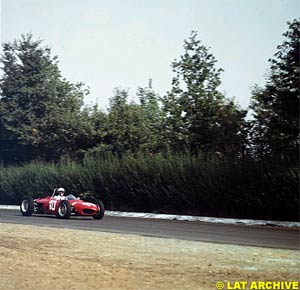 Although von Trips was on form during qualifying, Phil Hill had been plagued by mechanical problems during the practice sessions leading to the Monza race and could only qualify in fourth place, which gave the edge to von Trips on race day. Phil Hill experienced gearbox problems first and later on an engine down on power during practice. To Hill, the Monza Speedoval banking portion of the course was a barometer of how an engine was performing and Hill discovered that he was a full 1.5 seconds down to the other Sharknose Ferraris on the banking, so after the grid was set Hill went to Enzo Ferrari to complain. The Commendatore, not one known to coddle his drivers had a curt reply: "Maybe it's your foot."
Although von Trips was on form during qualifying, Phil Hill had been plagued by mechanical problems during the practice sessions leading to the Monza race and could only qualify in fourth place, which gave the edge to von Trips on race day. Phil Hill experienced gearbox problems first and later on an engine down on power during practice. To Hill, the Monza Speedoval banking portion of the course was a barometer of how an engine was performing and Hill discovered that he was a full 1.5 seconds down to the other Sharknose Ferraris on the banking, so after the grid was set Hill went to Enzo Ferrari to complain. The Commendatore, not one known to coddle his drivers had a curt reply: "Maybe it's your foot."
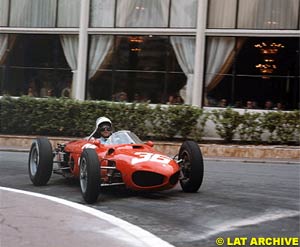 Phil Hill committed to Enzo Ferrari to stay with the team in the 1962 season. Over the winter of 1961/1962, however, tumult ruled at Ferrari, with eight executives departing, including Tavoni, Ferrari's team manager, and Carlo Chiti, the engineer who had convinced Enzo Ferrari to go to a rear-engined car and whose brainchild was the Sharknose Ferrari, gutting the team of the senior management that had brought victory to Maranello. The British teams, BRM and Lotus had new 1.5 litre V8s by 1962 and it soon began to become apparent that the Sharknose was outclassed.
Phil Hill committed to Enzo Ferrari to stay with the team in the 1962 season. Over the winter of 1961/1962, however, tumult ruled at Ferrari, with eight executives departing, including Tavoni, Ferrari's team manager, and Carlo Chiti, the engineer who had convinced Enzo Ferrari to go to a rear-engined car and whose brainchild was the Sharknose Ferrari, gutting the team of the senior management that had brought victory to Maranello. The British teams, BRM and Lotus had new 1.5 litre V8s by 1962 and it soon began to become apparent that the Sharknose was outclassed.
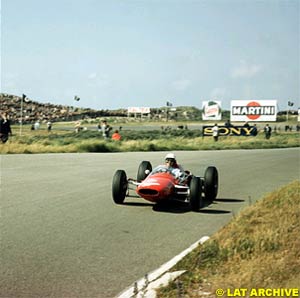 For a driver so quintessentially American who had been so successful in Europe and elsewhere, it is ironic that Lady Luck turned her back on Phil Hill, always in different and inventive ways, when it came to his home race - the US Grand Prix. In the first US Grand Prix at Sebring on December 12, 1959, Phil Hill was coming off a strong second place to Stirling Moss at the immediately preceding race at Monza. And as one of the winners of the 1959 Sebring 12-hour endurance race, Phil obviously knew the bumpy airport track well. For this inaugural race, Enzo Ferrari even had Hill's Ferrari Dino 246 specially painted in American racing colors, blue with a white nose, but though Hill started well, he was out with clutch problems by lap 8 of the 42 lap race.
For a driver so quintessentially American who had been so successful in Europe and elsewhere, it is ironic that Lady Luck turned her back on Phil Hill, always in different and inventive ways, when it came to his home race - the US Grand Prix. In the first US Grand Prix at Sebring on December 12, 1959, Phil Hill was coming off a strong second place to Stirling Moss at the immediately preceding race at Monza. And as one of the winners of the 1959 Sebring 12-hour endurance race, Phil obviously knew the bumpy airport track well. For this inaugural race, Enzo Ferrari even had Hill's Ferrari Dino 246 specially painted in American racing colors, blue with a white nose, but though Hill started well, he was out with clutch problems by lap 8 of the 42 lap race.
 For the 1963 US Grand Prix at Watkins Glen, Phil Hill and his teammate at ATS, Giancarlo Baghetti, both of them race winners in the Sharknose 156 in the halcyon days of 1961, were the anchor men in the problematic ATSs, retiring in 20th and 21st place, both going out with oil pump problems after completing a grand total of 4 laps between them! It would have been laughable if it were not so sad.
For the 1963 US Grand Prix at Watkins Glen, Phil Hill and his teammate at ATS, Giancarlo Baghetti, both of them race winners in the Sharknose 156 in the halcyon days of 1961, were the anchor men in the problematic ATSs, retiring in 20th and 21st place, both going out with oil pump problems after completing a grand total of 4 laps between them! It would have been laughable if it were not so sad.
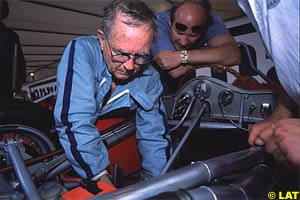 The air travel capabilities of the times also played a role in limiting the ability of someone racing in Grands Prix in Europe to compete in the Indy 500. In those years, participating in the Indianapolis 500 was a month-long affair, beginning on May 1st and continuing throughout the month of May until Memorial Day weekend. In the early 1960s, the Monaco Grand Prix and sometimes the Dutch Grand Prix were often held in May; as an example, the 1963 Monaco Grand Prix was held on Sunday, May 26, 1963, and the Indy 500 was on the next Thursday, May 30, 1963.
The air travel capabilities of the times also played a role in limiting the ability of someone racing in Grands Prix in Europe to compete in the Indy 500. In those years, participating in the Indianapolis 500 was a month-long affair, beginning on May 1st and continuing throughout the month of May until Memorial Day weekend. In the early 1960s, the Monaco Grand Prix and sometimes the Dutch Grand Prix were often held in May; as an example, the 1963 Monaco Grand Prix was held on Sunday, May 26, 1963, and the Indy 500 was on the next Thursday, May 30, 1963.
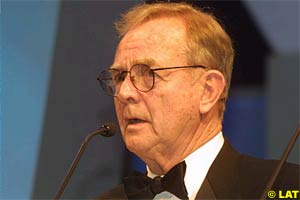 The replica is all we have of the famous car and it is such a good reproduction (except for the power plant which is a 2.4 litre instead of the original 1.5 litre engine) that Ferrari showed it alongside its other Championship Ferraris at commerative ceremonies in 1998 to mark Ferrari's 50th Anniversary. Interestingly, because Ferrari never sent the Sharknose 156 to the US Grands Prix of 1961 and 1962, this fabulous car has never run on American soil.
The replica is all we have of the famous car and it is such a good reproduction (except for the power plant which is a 2.4 litre instead of the original 1.5 litre engine) that Ferrari showed it alongside its other Championship Ferraris at commerative ceremonies in 1998 to mark Ferrari's 50th Anniversary. Interestingly, because Ferrari never sent the Sharknose 156 to the US Grands Prix of 1961 and 1962, this fabulous car has never run on American soil.
Please Contact Us for permission to republish this or any other material from Atlas F1.
|
Click here for Part I
Volume 7, Issue 40
Articles
Breakfast at Minardi
Phil Hill: Made in America - Part II
US GP Review
The US GP Review
Reflections from Indianapolis
McLaren's Sabbatical Year
The Last Hurrah
Columns
Qualifying Differentials
The F1 Insider
Season Strokes
The Weekly Grapevine
> Homepage |